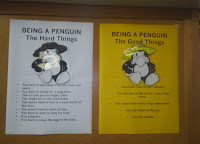In Room 5 we have been finding out and sorting out information about Penguins that live in Antarctica. After watching March of the Penguins we wrote our wonderings about Antarctic Penguins.
We wonder:
How long can Penguins live their life in Antarctica?
Why are Penguins Black and White?
How long have Penguins lived in Antarctica?
Are the Penguins going to live in the summertime?
We are now very interested in how Penguin adults care for their eggs and young.
We wonder:
Why do Penguins do a little dance to pass the egg?
How do the Penguins get their eggs to the other Penguin without it breaking?
What does the baby Penguin look like when it comes out?
Why do the Penguins have to sing to find their baby?
What would the Baby Penguin feel if the Mum and Dad died?
We are also wondering what might happen to Antarctic Penguins in the future.
We wonder:
What will happen to the Penguins in Antarctica?
How many Penguins will die in the next 5 years?
Will the Penguin Race last?
How can we save the Penguins?
We are now going on a learning journey to find out about Emporer, Adelie, Chinstrap and Gentoo Penguins.
Join us on our learning journey and help us to find out the answers to our questions.















